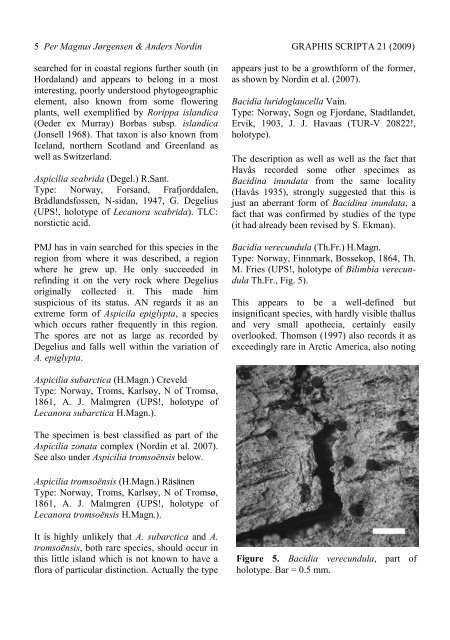(2009): Lichens in Scandinavia known mainly from Norwegian type ...
(2009): Lichens in Scandinavia known mainly from Norwegian type ...
(2009): Lichens in Scandinavia known mainly from Norwegian type ...
Create successful ePaper yourself
Turn your PDF publications into a flip-book with our unique Google optimized e-Paper software.
5 Per Magnus Jørgensen & Anders Nord<strong>in</strong> GRAPHIS SCRIPTA 21 (<strong>2009</strong>)<br />
searched for <strong>in</strong> coastal regions further south (<strong>in</strong><br />
Hordaland) and appears to belong <strong>in</strong> a most<br />
<strong>in</strong>terest<strong>in</strong>g, poorly understood phytogeographic<br />
element, also <strong>known</strong> <strong>from</strong> some flower<strong>in</strong>g<br />
plants, well exemplified by Rorippa islandica<br />
(Oeder ex Murray) Borbas subsp. islandica<br />
(Jonsell 1968). That taxon is also <strong>known</strong> <strong>from</strong><br />
Iceland, northern Scotland and Greenland as<br />
well as Switzerland.<br />
Aspicilia scabrida (Degel.) R.Sant.<br />
Type: Norway, Forsand, Frafjorddalen,<br />
Brådlandsfossen, N-sidan, 1947, G. Degelius<br />
(UPS!, holo<strong>type</strong> of Lecanora scabrida). TLC:<br />
norstictic acid.<br />
PMJ has <strong>in</strong> va<strong>in</strong> searched for this species <strong>in</strong> the<br />
region <strong>from</strong> where it was described, a region<br />
where he grew up. He only succeeded <strong>in</strong><br />
ref<strong>in</strong>d<strong>in</strong>g it on the very rock where Degelius<br />
orig<strong>in</strong>ally collected it. This made him<br />
suspicious of its status. AN regards it as an<br />
extreme form of Aspicila epiglypta, a species<br />
which occurs rather frequently <strong>in</strong> this region.<br />
The spores are not as large as recorded by<br />
Degelius and falls well with<strong>in</strong> the variation of<br />
A. epiglypta.<br />
Aspicilia subarctica (H.Magn.) Creveld<br />
Type: Norway, Troms, Karlsøy, N of Tromsø,<br />
1861, A. J. Malmgren (UPS!, holo<strong>type</strong> of<br />
Lecanora subarctica H.Magn.).<br />
The specimen is best classified as part of the<br />
Aspicilia zonata complex (Nord<strong>in</strong> et al. 2007).<br />
See also under Aspicilia tromsoënsis below.<br />
Aspicilia tromsoënsis (H.Magn.) Räsänen<br />
Type: Norway, Troms, Karlsøy, N of Tromsø,<br />
1861, A. J. Malmgren (UPS!, holo<strong>type</strong> of<br />
Lecanora tromsoënsis H.Magn.).<br />
It is highly unlikely that A. subarctica and A.<br />
tromsoënsis, both rare species, should occur <strong>in</strong><br />
this little island which is not <strong>known</strong> to have a<br />
flora of particular dist<strong>in</strong>ction. Actually the <strong>type</strong><br />
appears just to be a growthform of the former,<br />
as shown by Nord<strong>in</strong> et al. (2007).<br />
Bacidia luridoglaucella Va<strong>in</strong>.<br />
Type: Norway, Sogn og Fjordane, Stadtlandet,<br />
Ervik, 1903, J. J. Havaas (TUR-V 20822!,<br />
holo<strong>type</strong>).<br />
The description as well as well as the fact that<br />
Havås recorded some other specimes as<br />
Bacid<strong>in</strong>a <strong>in</strong>undata <strong>from</strong> the same locality<br />
(Havås 1935), strongly suggested that this is<br />
just an aberrant form of Bacid<strong>in</strong>a <strong>in</strong>undata, a<br />
fact that was confirmed by studies of the <strong>type</strong><br />
(it had already been revised by S. Ekman).<br />
Bacidia verecundula (Th.Fr.) H.Magn.<br />
Type: Norway, F<strong>in</strong>nmark, Bossekop, 1864, Th.<br />
M. Fries (UPS!, holo<strong>type</strong> of Bilimbia verecundula<br />
Th.Fr., Fig. 5).<br />
This appears to be a well-def<strong>in</strong>ed but<br />
<strong>in</strong>significant species, with hardly visible thallus<br />
and very small apothecia, certa<strong>in</strong>ly easily<br />
overlooked. Thomson (1997) also records it as<br />
exceed<strong>in</strong>gly rare <strong>in</strong> Arctic America, also not<strong>in</strong>g<br />
Figure 5. Bacidia verecundula, part of<br />
holo<strong>type</strong>. Bar = 0.5 mm.

















